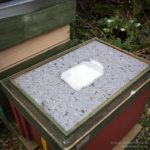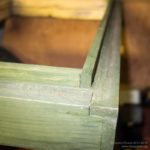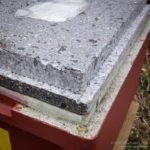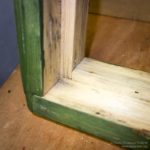Poly nuc insulated eke
The lid on Paynes poly nuc boxes is very thin. This, and the internal feeder, are the weakest features of what is otherwise a well designed, robust and useful box. You can improve the box hugely by butchering it removing the internal feeder. This generates an eight frame nuc box which is also a good size (and weight … when struggling up or down a ladder) for housing all but the largest swarms. However, other than during the summer, the lid is far too thin. On a morning with a heavy frost the thawed patch above the cluster is very obvious. I’m convinced that top insulation is very important; I build crown board with internal insulation or roofs with integral Kingspan insulation for all my full-size hives. With a little ingenuity and some primitive woodworking skills it is possible to construct an insulated eke for these Paynes poly nucs that has the additional advantage of allowing you to feed fondant to the colony.
Kingspan and most other expanded polystyrene-type (that’s probably not exactly the correct term, but it’s a description most will understand) insulation is 50mm thick. Since my woodworking skills are limited and I lack anything other than a simple saw I have to work with the softwood sizes available off the shelf (at my excellent local Shepherds DIY store). Therefore, using 46 x 21mm softwood I build an eke, with simple rebated joints, that fits onto the nuc box, outside the short raised lip. This then needs an additional shim of 9 x 21mm softwood around the top edge. I add a thin strip of 3mm thick stripwood to the inside top edge of the eke and then create the raised lip (over which the lid will fit) using 32 x 9mm softwood (this is much easier to show in a photo than to describe). The intention is that the lid fits neatly over the ‘new’ raised lip, forming a reasonable seal against the weather.
After adding two to three coats of a suitable bee-safe wood preservative like Ronseal Fence Life I prepare a block of Kingspan or Jablite insulation, carving out a rebate to fit the raised lip of the eke … again, the photo should make this much clearer. FInally, cut a hole in the insulation to take a “carry out” food container with fondant. Don’t discard the piece you cut out … use it to fill the space if you’re not going to be adding fondant.
In the summer I usually use 2mm Perspex crown boards on these poly nuc boxes. After an inspection they can easily be slid across the top of the box, pushing bees away and down out of the way. These crown boards have no feeding holes in them. Therefore, in the winter I prepare a sheet of thick translucent polythene with a suitably placed flap over the top bars, add the fondant block and the insulated eke, topping the entire thing off with the 2mm Perspex sheet and the poly lid. The latter can easily blow away – make sure you strap it down or add a brick on top.




Join the discussion ...